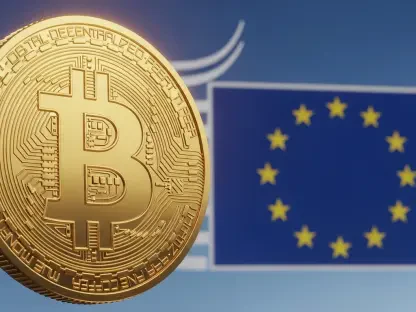Today we have the pleasure of interviewing Desiree Sainthrope, a renowned legal expert with vast experience in drafting and analyzing trade agreements, global compliance, intellectual property, and the evolving implications of technologies like AI. Desiree is here to share her insights into the intricate world of cryptocurrency regulation and her recent offer to provide free advisory services to governments interested in crypto adoption.
What motivated you to offer free crypto advisory services to governments?
My motivation stems from an understanding that clear, supportive regulations can drive innovation while protecting consumers and economies. With my background in global compliance and a keen interest in the evolving landscape of digital assets, I see an opportunity to assist governments in navigating this complex space. Providing advisory services ensures that these frameworks are built on a solid foundation of knowledge and best practices.
Are there any specific regions or countries you are targeting with this offer?
The focus is global, but the offer is particularly aimed at countries showing a genuine interest in adopting digital assets and creating a regulatory environment conducive to innovation. Countries in Asia and emerging markets, for example, have shown significant potential. By targeting these regions, I hope to create case studies that other countries can learn from.
How do you plan to manage your available time to accommodate these advisory roles?
Time management is crucial. I intend to establish a structured advisory schedule and work closely with a dedicated team to handle multiple engagements efficiently. Prioritizing projects based on their potential impact and urgency will help ensure I can offer meaningful advice without compromising my other commitments.
What are the key aspects that governments should consider when developing crypto regulations?
Governments should consider fostering innovation while ensuring consumer protection, financial stability, and compliance with existing laws. Transparency, anti-money laundering measures, and counter-terrorism financing protocols are critical. Public consultations involving industry stakeholders can also provide valuable insights.
How can governments balance innovation in the crypto industry with necessary compliance measures?
Balancing innovation with compliance requires a regulatory framework that is both flexible and clear. Governments should engage with experts and stakeholders continuously and adapt regulations as the industry evolves. Sandboxes for testing new technologies can also help regulators and businesses refine their approaches without stifling innovation.
Do you believe there should be a universal framework for crypto regulations, or should each country have unique regulations?
A universal framework can provide a baseline of standards that enhance cross-border cooperation and reduce regulatory arbitrage. However, countries need room to adapt these guidelines to their specific legal, economic, and cultural contexts. Hybrid models can offer global consistency while accommodating local nuances.
How has your role in the cryptocurrency industry evolved since stepping down from Binance?
My role has transitioned from operational leadership to a more advisory and strategic capacity. I am now focusing on shaping regulatory policies and frameworks at a higher level. This shift allows me to influence broader industry directions and support foundational developments that will benefit the global crypto ecosystem.
Do you feel your decisions and statements still have the same impact as when you were the CEO of Binance?
While the nature of my influence has changed, it remains significant, perhaps even more so in certain respects. As an independent expert, my advice is seen as impartial and grounded in extensive industry knowledge, which can resonate more strongly with policymakers and regulators.
What major differences do you see in the industry’s direction now compared to when you were leading Binance?
The industry has matured significantly, with increased institutional involvement and clearer regulatory focus. There’s a greater emphasis on compliance and sustainability, reflecting a shift from the early days of rapid growth and innovation. This evolution is crucial for long-term stability and mainstream acceptance.
Can you elaborate on your advisory role with Pakistan’s Crypto Council? What are the main goals?
My role involves helping Pakistan develop a robust crypto infrastructure and nurturing talent through education and training programs. The main goals include establishing secure regulatory frameworks, promoting blockchain technology, and fostering an environment conducive to innovation and economic growth.
How did your collaboration with Malaysian government officials come about, and what are the expected outcomes?
The collaboration began through mutual interest in leveraging digital assets to drive economic development. The expected outcomes include the formulation of regulatory guidelines that encourage innovation while ensuring consumer protection and financial stability. This partnership aims to position Malaysia as a regional leader in digital finance.
What is the significance of the Memorandum of Understanding you signed with Kyrgyzstan?
The MoU with Kyrgyzstan signifies a commitment to enhancing the country’s blockchain and crypto infrastructure. It aims to foster educational initiatives and governance models that support digital asset integration into the economy. This agreement underscores a collaborative approach to developing a sustainable crypto ecosystem.
What long-term impact do you hope to achieve through your advisory services to various governments?
The long-term goal is to create regulatory environments that balance innovation with safety and compliance, fostering global economic growth. By helping countries develop practical and forward-thinking frameworks, I hope to see a world where digital assets contribute positively to economic inclusivity and technological advancement.
In your view, what would a crypto-friendly regulatory framework look like?
A crypto-friendly regulatory framework would support innovation, ensure clear legal definitions, offer robust consumer protections, and provide flexibility to adapt to technological advancements. It should encourage transparency and accountability, reduce barriers to entry, and foster international cooperation.
How do you see your guidance influencing global economic growth through digital assets?
By advising on balanced, innovative regulatory frameworks, my guidance can help integrate digital assets into the global economy securely and efficiently. This integration can promote financial inclusion, enable new business models, and drive technological advancement, ultimately contributing to global economic growth.
What are the biggest challenges you foresee for the global adoption of cryptocurrency?
The biggest challenges include regulatory uncertainty, cybersecurity concerns, and public skepticism. Bridging the knowledge gap for both regulators and consumers is critical, as is developing secure, scalable infrastructure. Overcoming these challenges requires collaboration across all industry stakeholders.
Where do you envision the cryptocurrency industry in the next five to ten years?
In the next five to ten years, I envision the cryptocurrency industry becoming more integrated into the global financial system, with clear regulations facilitating broader adoption. Innovations in blockchain technology will likely drive new applications across various sectors, creating a more decentralized and inclusive economic landscape.









